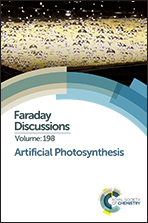Stabilisation effects of phosphane ligands in the homogeneous approach of sunlight induced hydrogen production†
Abstract
Most of the systems for photochemical hydrogen production are not stable and suffer from decomposition. With bis(bidentate) tetraphosphane ligands the stability increases enormously, up to more than 1000 h. This stability was achieved with a system containing osmium(II) as a light harvesting antenna and palladium(II) as a water reduction catalyst connected with a bis(bidentate) phosphane ligand in one molecule with the chemical formula [Os(bpy)2(dppcb)Pd(dppm)](PF6)4. With the help of electrochemical measurements as well as photophysical data and its single crystal X-ray structure, the electron transfer between the two active metal centres (light harvesting antenna, water reduction catalyst) was analysed. The distance between the two active metal centres was determined to be 7.396(1) Å. In a noble metal free combination of a copper based photosensitiser and a cobalt diimine–dioxime complex as water reduction catalyst a further stabilisation effect by the phosphane ligands is observed. With the help of triethylamine as a sacrificial donor in the presence of different monophosphane ligands it was possible to produce hydrogen with a turnover number of 1176. This completely novel combination is also able to produce hydrogen in a wide pH-range from pH = 7.0 to 12.5 with the maximum production at pH = 11.0. The influence of monophosphane ligands with different Tolman cone angles was investigated. Monophosphane ligands with a large Tolman cone angle (>160°) could not stabilise the intermediate of the cobalt based water reduction catalyst and so the turnover number is lower than for systems with an addition of monophosphane ligands with a Tolman cone angle smaller than 160°. The role of the monophosphane ligand during sunlight-induced hydrogen production was analysed and these results were confirmed with DFT calculations. Furthermore the crystal structures of two important Co(I) intermediates, which are the catalytic active species during the catalytic pathway, were obtained. The exchange of PPh3 with other tertiary phosphane ligands can have a major impact on the activity, depending on the coordination properties. By an exchange of monophosphane ligands with functionalised phosphane ligands (hybrid ligands) the hydrogen production was raised 2.17 times.
- This article is part of the themed collection: Artificial Photosynthesis

 Please wait while we load your content...
Please wait while we load your content...